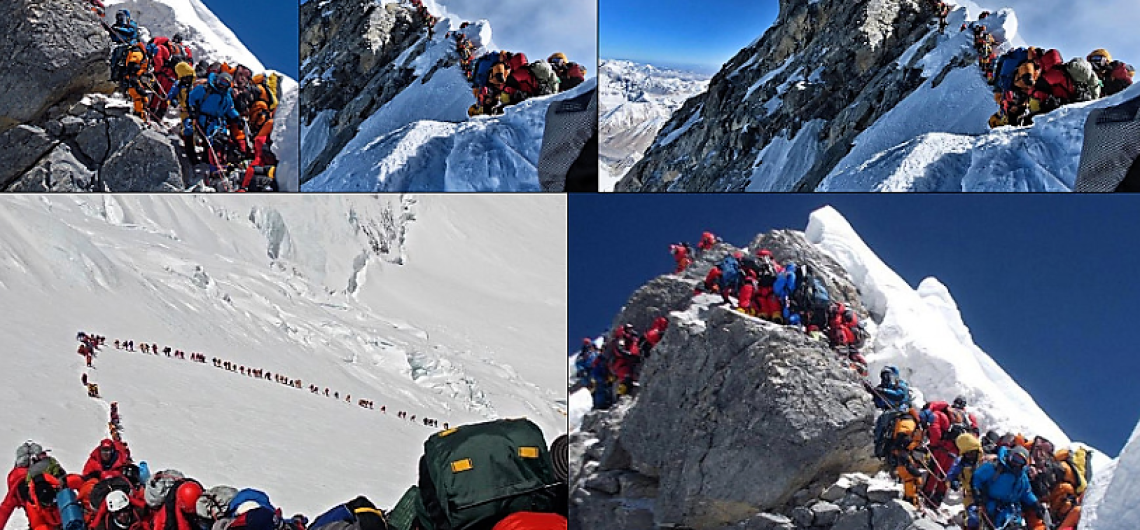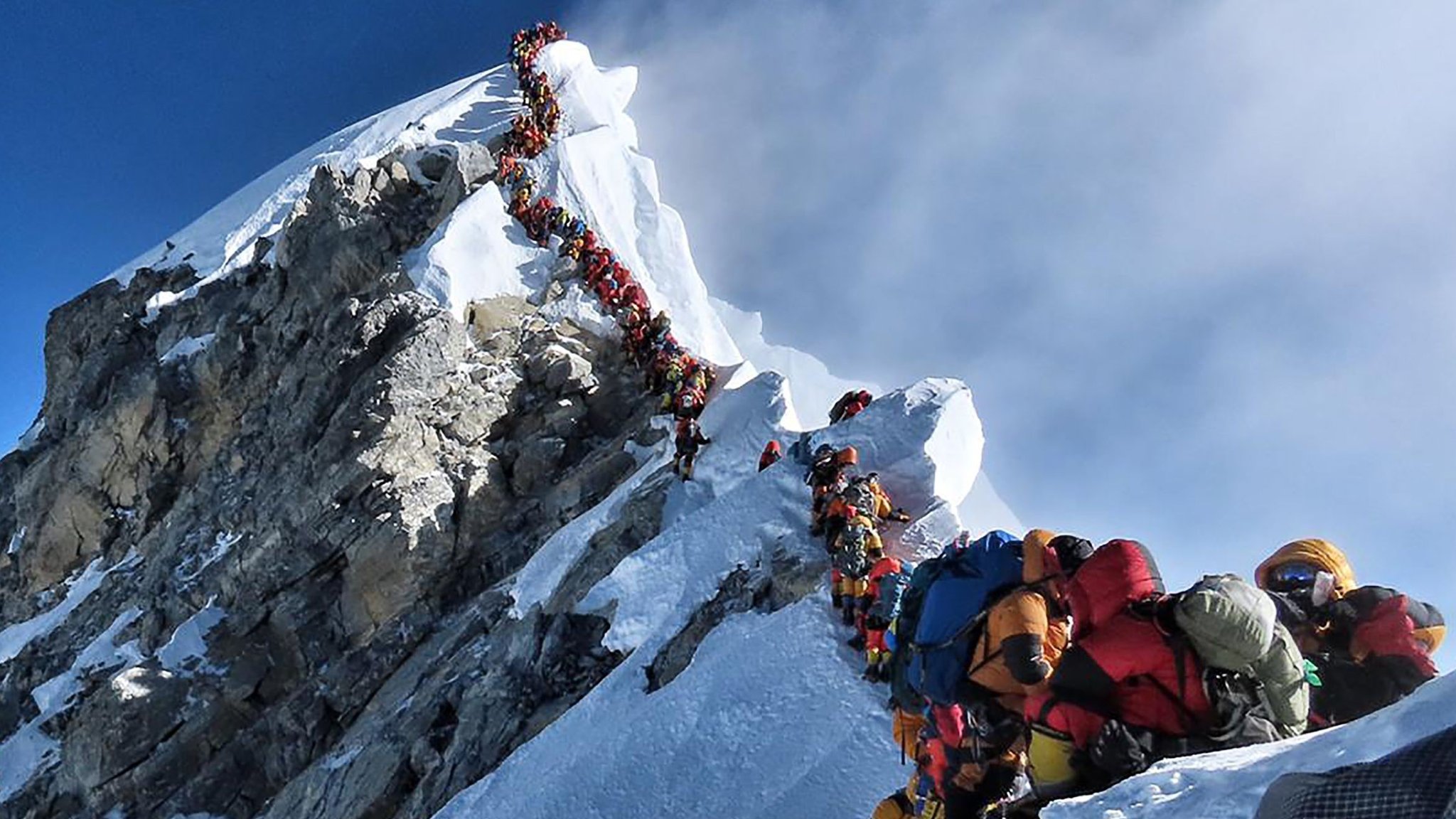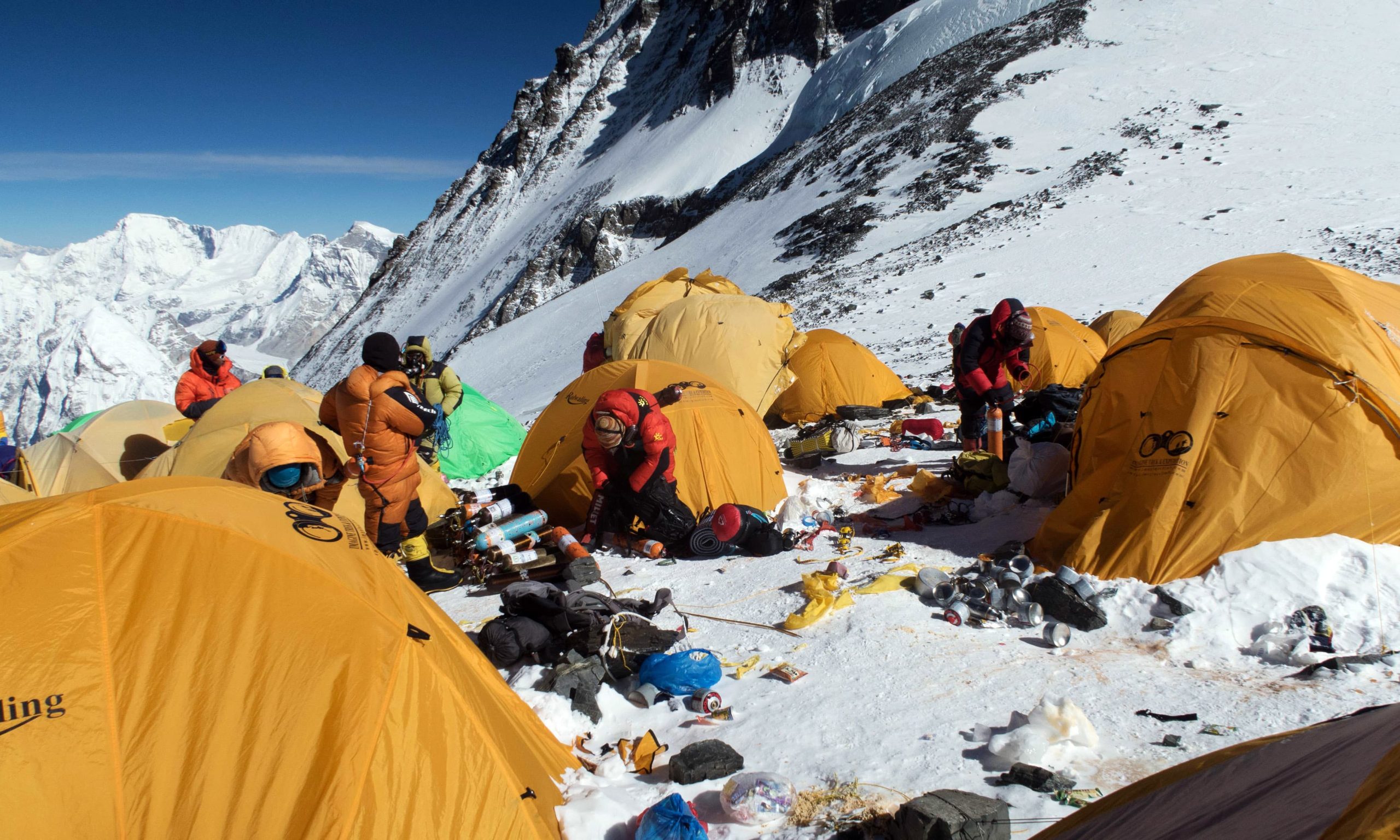Mountaineers must navigate overcrowded traffic, a sprawling and dirty base camp, and an increasingly deadly environment in their quest to reach one of the most popular destinations on Earth. Recent attention has been drawn to the overcrowded conditions on Mount Everest, following the disappearance and presumed death of two climbers after a portion of an icy ridge collapsed. Social media videos depict a long line of climbers stranded after a tragic incident that claimed the lives of British climber Daniel Paterson and his Nepali guide.
These images reveal the chaotic rush to conquer the world’s highest peak, with some climbers witnessing horrifying scenes of deceased individuals passing by. Despite reaching the summit, Paterson and his team members remained missing, as did another climber who perished, highlighting the extreme risks associated with climbing Everest. Himalayan mountaineer Rajan Dwivedi emphasized the seriousness of the climb, pointing out the disregard for human life and environmental degradation that occur at such high altitudes for the sake of achieving the summit.
Kenyan, Cheruiyot Kirui found dead on Everest after he was reported missing near the summit
The delay to the summit caused by long queues and overcrowding could result: potentially lead to exhaustion and dehydration for climbers and a decrease in oxygen levels of the climbers, resulting in their sickness and exhaustion
“I estimate that more than 7,000 climbers have successfully reached the summit of Mount Everest since the first ascent in May 1953. Many of these climbers have suffered from frostbite, snow blindness, and other types of injuries that are not officially recorded,” he stated in a post that featured a video showing a long line of climbers moving up and down the mountain during a brief period of favourable weather conditions. “This video demonstrates the challenging conditions we encounter while navigating through the traffic of climbers going in different directions on a single rope. The primary motivation for this traffic is the need to take advantage of a narrow window of good weather to avoid powerful jet streams that can reach speeds of 100-240mph!! Descending was particularly difficult and tiring for me, with a huge line of climbers ascending to make the most of the weather window.”
In Nepal, the towering Mount Everest is also known as “Sagarmatha,” which translates to “forehead in the sky.” Reaching a majestic height of 8,849 meters (29,032 feet), it reigns as the highest mountain above sea level worldwide. Nestled within the vast Himalayan mountain range, which stretches an impressive 2,400 kilometers (1,500 miles) and winds through six different countries in Asia. In 1953, Edmund Hillary and Tenzing Norgay etched their names in history as the first individuals to officially conquer the summit of Mount Everest. Their remarkable accomplishment showcased incredible strength and perseverance, capturing the awe and fascination of people around the globe. Since that groundbreaking achievement, throngs of visitors have traveled to the mountain, leaving behind a staggering amount of litter and contributing to the overcrowding. This has led to concerns about the environmental impact, earning Everest the unfortunate moniker of the “world’s highest garbage dump.”
Growing Concerns Surrounding Mount Everest’s Crowded Conditions
Despite the frequent accidents and deaths on Everest, the mountain’s popularity remains strong. Currently, the season is bustling with activity, as hundreds of climbers are packed together along the Hillary Step. Mountaineering guide Vinayak Jaya Malla recently witnessed a cornice collapsing while descending from the summit. The climbers were in a dangerous situation, but thankfully were able to rescue themselves. Unfortunately, two climbers are still missing. The traffic on the fixed line made it challenging to maneuver, with climbers running low on oxygen.
Francys Arsentiev – The Sleeping Beauty of Mount Everest
Malla had to break a new route to ease the congestion. Another climber, Dwivedi, described feeling conflicted after seeing fellow climbers in distress, hanging onto ropes while their Sherpas worked to bring them down. Some climbers were in a disoriented state, causing delays and congestion.
 Climbers missing presumed dead after the icy cornice collapse in treacherous ‘death zone’
Climbers missing presumed dead after the icy cornice collapse in treacherous ‘death zone’
One climber on described the situation on Everest as “
At 6:00 am on May 21, 2024, I, along with @luchin.vig and Budhha stood atop the world’s highest peak and are now safely back in Base Camp.
The Everest summit ridge felt different than my previous experiences on the mountain. There was soft snow, many cornices and rocky sections covered in snow. The weather station was even half buried in snow.
After summiting, we crossed the Hillary Step, traffic was moving slowly then suddenly a cornice collapsed a few meters ahead of us. There was also a cornice under us.
As the cornice collapsed, four climbers nearly perished yet were clipped onto the rope and self-rescued. Sadly, two climbers are still missing. We tried to traverse yet it was impossible due to the traffic on the fixed line.
Many climbers were stuck in the traffic and oxygen was running low. I was able to start breaking a new route for the descending traffic to begin moving slowly once again.
We returned to rest at Camp 3 and proceeded back to Base Camp on May 22.”
View this post on Instagram
Two climbers who have gone missing are now presumed dead after a portion of a frozen ridge collapsed on Mount Everest during an unfortunate and deadly week on the highest peak in the world. British climber Daniel Paterson, aged 39, and his Nepali guide, Pas Tenji Sherpa, aged 23, have failed to be located even days after a cornice, which is a mass of compacted snow projecting over the edge of a cliff, unexpectedly crumbled on Tuesday. According to The BBC, they were part of a 15-person team that had successfully reached the summit of Mount Everest, standing at 29,032 feet above sea level. The incident occurred as they were descending the crowded mountain. The organizer of the expedition, Mount Everest adventure company 8K Expeditions, stated that they “were caught in a sudden cornice fall, which affected the group of climbers.” Despite extensive search operations, it has been confirmed with great sadness that Daniel and Pas Tenji could not be found or rescued, as conveyed by the company through a heartfelt message on Instagram posted on Thursday.
The collapse took place at around 4:40 a.m. on Tuesday near the Hillary Step while Paterson and Sherpa were descending. Social media videos show a long line of climbers stranded in the area aftermath. This location falls within Everest’s “death zone,” at an elevation of over 26,000 feet, where lack of oxygen and air pressure can be deadly over prolonged periods. Sherpa, described as a top guide, had conquered Everest twice and other significant peaks, while Paterson, a co-owner of CrossFit from Wakefield, had summited Island Peak and Ama Dablam. Paterson’s partner, Becks Woodhead, has raised over $128,000 for a recovery mission. In a separate incident, Kenyan climber Joshua Cheruiyot Kirui, 40, was found deceased, and his guide, Nawang Sherpa, 44, remains missing after they went missing from the mountain. Sherpa informed base camp that Kirui had unusual behavior and refused oxygen before the disappearance. Kirui’s hiking friend, Kipkemoi Limo, mentioned to the BBC that he died in a fall and his body was discovered over 60 feet below the peak.
“I woke up to tears this morning upon receiving news that my brother @cheruiyot_ak has passed away on the mountain,” shared fellow climber James Muhia in a tweet. “Today is a somber day. Our brother is now one with the mountain. It will be a challenging time ahead. Rest in peace, my brother.” Gabriel Tabara from Romania was also discovered deceased inside his tent at Camp III on Tuesday, as reported by the Himalayan Times. Additionally, two Mongolian climbers, Usukhjargal Tsedendamba and Prevsuren Lkhagvajav, lost their lives in the death zone while descending the summit on May 13. The rise in fatality rates on Everest has been attributed to overcrowding and climate change.
The World’s Highest Garbage Dump
Established in 1976, Sagarmatha National Park was designated with the purpose of safeguarding the natural beauty and wildlife of the mountain region, ultimately achieving UNESCO World Heritage Site status in 1979. Drawing in approximately 100,000 visitors annually, the park faces environmental strain due to the high volume of tourists. Deforestation is a significant issue, as trees are felled to construct lodging and supply firewood. The path to Base Camp is heavily trodden, hosting up to 500 hikers daily during peak season, causing erosion. However, the greatest concern lies on Mount Everest itself, where over 600 climbers attempt to summit the peak each climbing season. A local support workforce, including guides, cooks, and porters, accompany each climber, intensifying crowding on the mountain. The influx of climbers often results in long queues and overcrowding at the summit, where the thin air mandates the use of oxygen masks. The mountain is marred by waste left behind by climbers, including discarded oxygen canisters, tents, food containers, and human waste. This accumulating garbage poses a threat to the area’s ecosystem and the health of those living in the Everest watershed, which serves as a vital water source for nearby communities. With inadequate waste management facilities, trash and sewage are deposited in pits near villages and carried into water sources during the monsoon season, leading to contamination and potential public health hazards like cholera and hepatitis A.
 What Goes Up Must Come Down
What Goes Up Must Come Down
Various efforts have been made by both governmental authorities and non-governmental organizations to address the environmental challenges on Mount Everest. In 2019, the Nepali government initiated a campaign aimed at removing 10,000 kilograms (22,000 pounds) of waste from the mountain. A refundable deposit system was also introduced in 2014, requiring climbers to pay a $4,000 deposit, which is returned upon bringing back eight kilograms (18 pounds) of trash – the estimated average waste generated by a single climber during the ascent. Apart from governmental actions, organizations like the Sagarmatha Pollution Control Committee (SPCC), comprising local Sherpa individuals, have been actively involved in preserving the cleanliness of the region. The SPCC not only manages waste disposal around Mount Everest but also ensures climbers have legal permits and educates visitors on environmental conservation practices. Additionally, the Mount Everest Biogas Project is pursuing a sustainable solution to the sanitation challenges in the area. Their proposal involves implementing a solar-powered system to convert human waste into fuel, alleviating the problem of dumping feces in local communities, reducing water contamination risks, and creating employment opportunities. Since the historic ascent of Edmund Hillary and Tenzing Norgay in 1953, thousands of people have attempted to reach the summit, with hundreds making the climb each season. While concerns have been raised about enforcing stricter regulations on the number of climbers on Mount Everest, Nepal heavily relies on the revenue generated by climbing permits. With a significant portion of the population living below the poverty line, the income generated from climbers plays a vital role in the local economy, providing jobs and income for locals involved in hospitality and guiding services.
Hope for the Future
In the Tibetan language, the majestic Mount Everest is known as “Chomolungma” – which translates to “goddess mother of the world.” To the Sherpa community, this towering peak holds great sacred significance, symbolizing a place of reverence and honour. Once a pristine and untouched landscape, Mount Everest has unfortunately fallen victim to pollution and environmental degradation due to the influx of climbers and inadequate waste management practices. Despite these challenges, there is optimism that initiatives such as the SPCC and the Mount Everest Biogas Project, with support from climbers and the Nepali government, can work towards restoring this iconic peak to its former splendour.
- Frank Smythe – The first professional mountaineer’s secret from the 1936 Everest Expedition
- 2 Mongolian Climbers Usukhjargal Tsedendamba and Prevsuren Lkhagvajav perish on Everest while climbing without oxygen and guides
- Nirmal Nims Purja MBE, a.k.a Nimsdai, King of the Mountains and EliteExped
- Who is Green Boots, the famous body on Mount Everest?
- Francys Arsentiev – The Sleeping Beauty of Mount Everest
- Andrew Sandy Irvine: The lost body on Everest
- Norwegian woman, Kristin Harila beats Nims Purja’s record to complete the fastest ascent of all of the world’s 14 highest mountains
- How David Sharp met his controversial death on Mount Everest in 2006
![]()




Comments